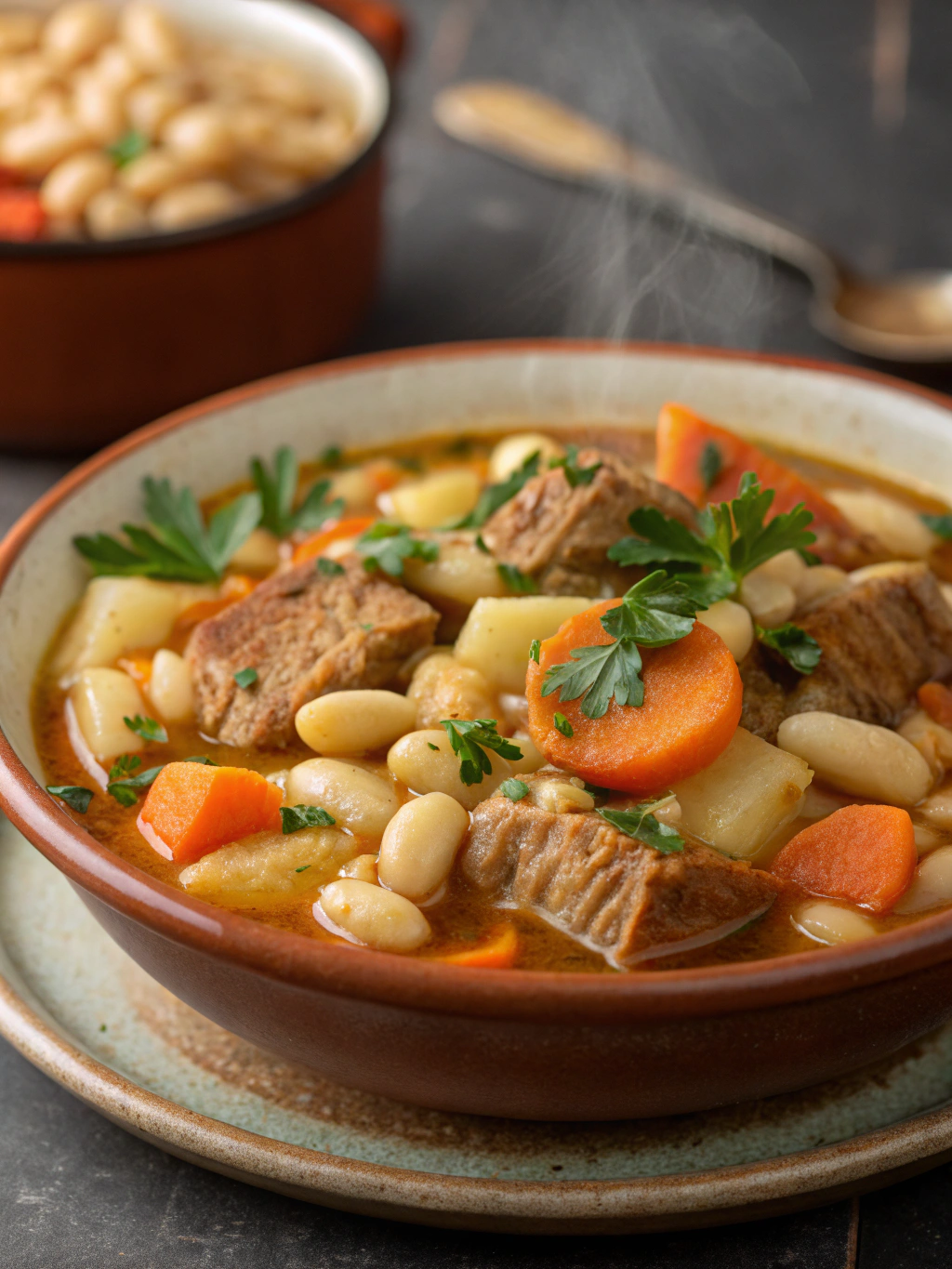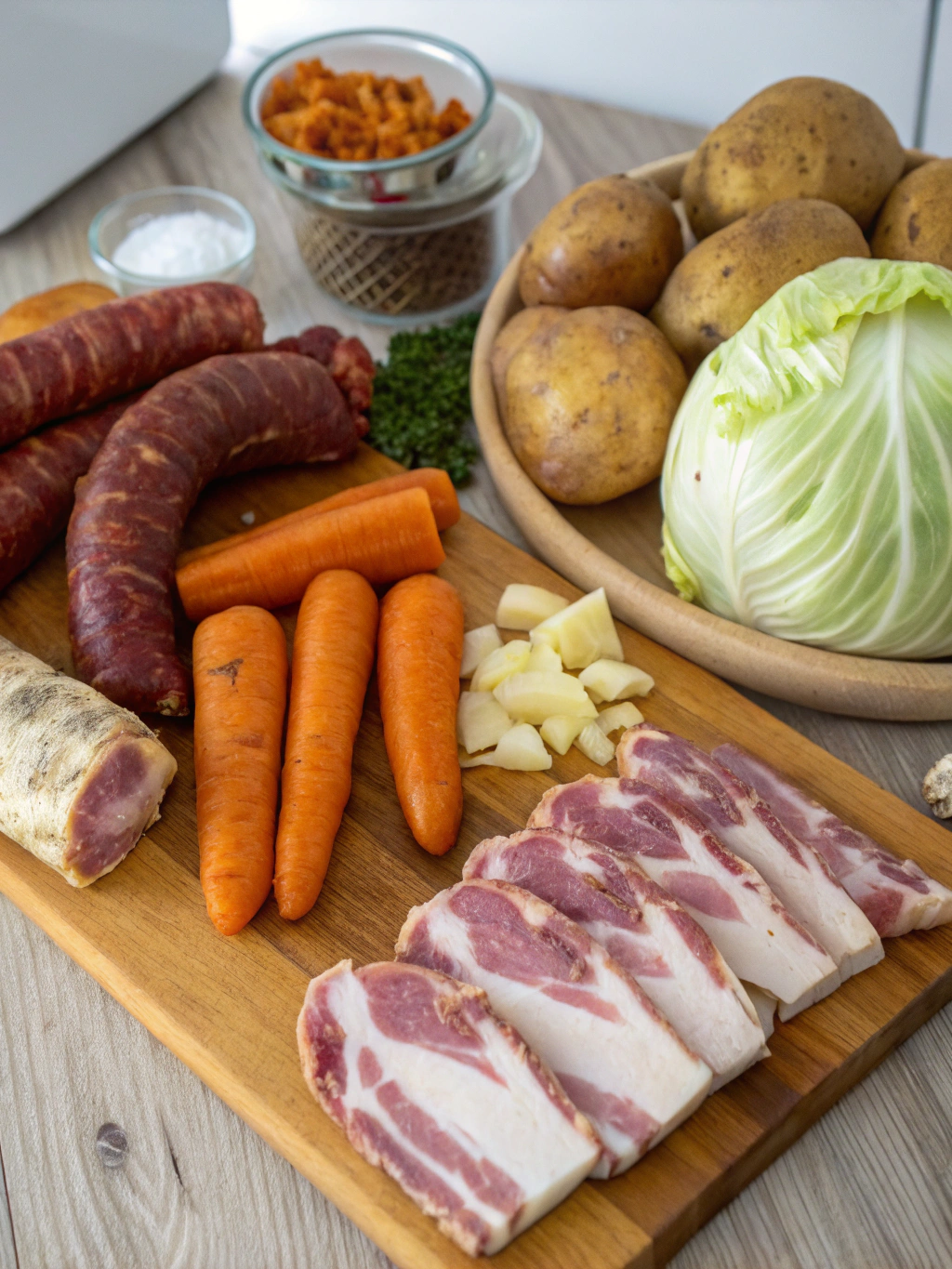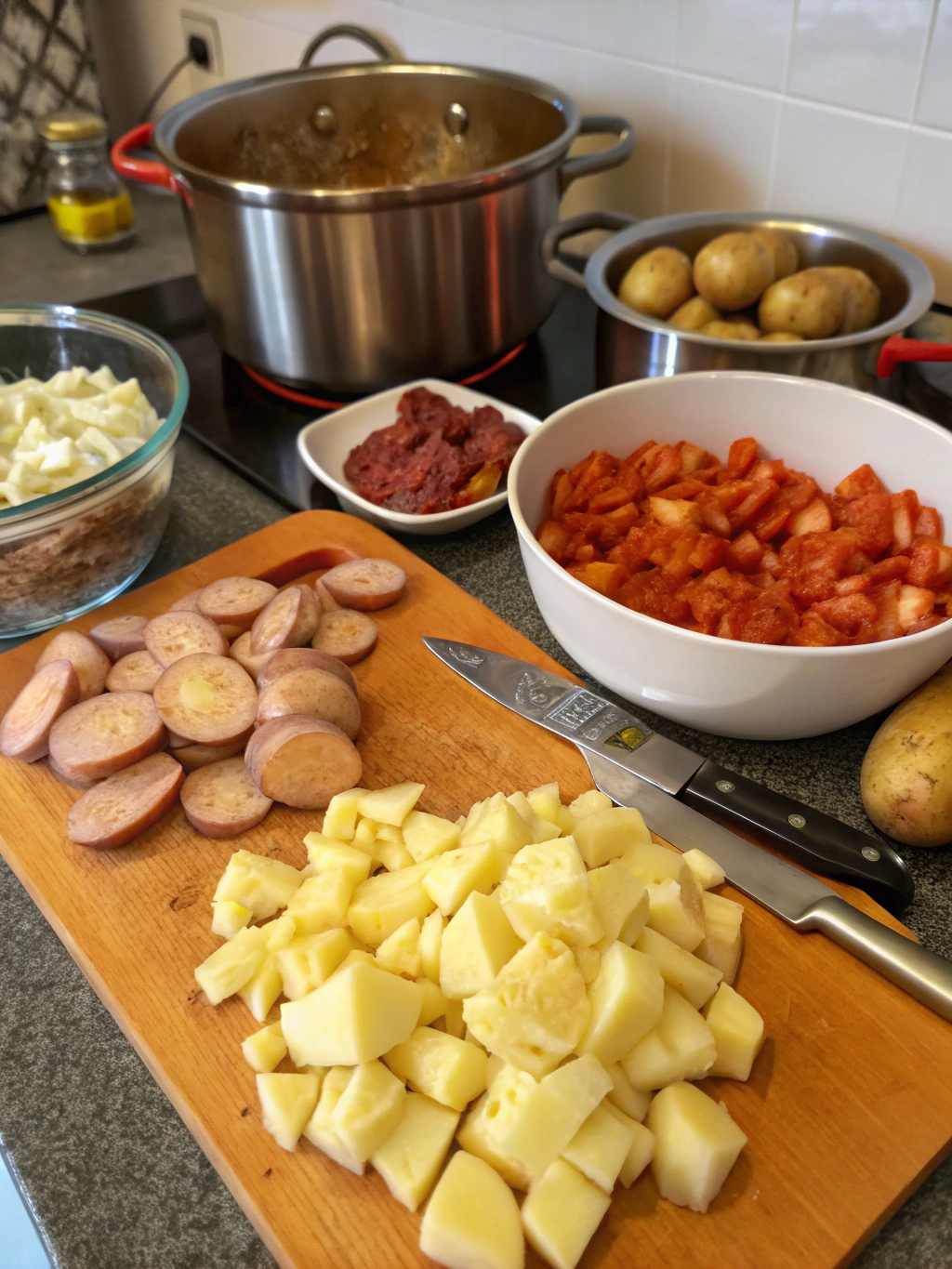
Did you know that Tripas à Moda do Porto is so deeply ingrained in Portuguese culture that locals from Porto are nicknamed "tripeiros" (tripe eaters), and this humble dish contributed to Portugal's Age of Discovery by feeding explorers who sailed the world? This legendary stew has nourished generations since the 14th century, when Porto's citizens gave their best meat to sailors heading to conquer Ceuta, keeping only the offal for themselves. Today, this hearty Tripas à Moda do Porto remains a symbol of resilience and resourcefulness, transforming simple ingredients into a gastronomic masterpiece that attracts food enthusiasts worldwide. Whether you're exploring Portuguese cuisine or seeking authentic comfort food, this traditional recipe delivers layers of flavor that tell the story of a city's sacrifice and ingenuity.
Ingredients List

Creating authentic Tripas à Moda do Porto requires a carefully curated selection of ingredients that work in harmony to create its distinctive taste. The combination of various meats, aromatic vegetables, and creamy white beans creates a symphony of flavors that defines this iconic dish.
Essential Ingredients:
- 500g honeycomb tripe (cleaned and pre-boiled)
- 200g veal tripe (optional, for added texture)
- 150g smoked pork sausage (chouriço)
- 150g blood sausage (morcela)
- 100g smoked bacon or pork belly
- 1 veal knuckle or ham bone
- 1 chicken leg quarter
- 400g dried white beans (soaked overnight)
- 2 large onions, finely chopped
- 4 cloves garlic, minced
- 2 bay leaves
- 1 tablespoon sweet paprika
- 1/2 teaspoon ground cumin
- 2 tablespoons olive oil
- Salt and white pepper to taste
- Fresh parsley for garnish
Ingredient Substitutions:
For those seeking alternatives, turkey sausage can replace traditional chouriço, while vegetarian blood sausage substitutes are available in specialty stores. The veal knuckle can be substituted with additional ham bones for a similar depth of flavor. If honeycomb tripe is unavailable, use only veal tripe, though the texture will differ slightly from the traditional preparation.
Timing
Preparing Tripas à Moda do Porto is a labor of love that rewards patience with incredible flavor development. The total time investment is approximately 4-5 hours, which is actually 20% less than many traditional Portuguese stews that simmer all day.
Time Breakdown:
- Preparation time: 45 minutes
- Active cooking time: 30 minutes
- Simmering time: 3-4 hours
- Resting time: 15 minutes before serving
This timing allows the collagen in the tripe to break down properly, creating the signature silky texture while the beans absorb the rich flavors of the meats and spices.
Step 1: Prepare the Tripe
Begin your como fazer tripas à moda do porto journey by thoroughly cleaning the tripe under cold running water. Even pre-cleaned tripe benefits from an additional rinse. Cut the honeycomb tripe into 2-inch squares, ensuring uniform pieces for even cooking. If using veal tripe, slice it into similar-sized strips. This preparation step is crucial as properly sized pieces ensure every bite contains the perfect texture balance.
Step 2: Sauté the Aromatics

Heat olive oil in a large, heavy-bottomed pot over medium heat. Add the finely chopped onions and sauté until they become translucent and golden, approximately 8-10 minutes. This slow caramelization process develops the sweet undertones that balance the rich meats. Add minced garlic and continue cooking for another 2 minutes until fragrant, being careful not to burn the garlic as it would introduce unwanted bitterness.
Step 3: Build the Flavor Base
Introduce the paprika and cumin to the aromatic base, stirring constantly for 30 seconds to bloom the spices. This technique releases their essential oils and intensifies their flavor contribution. Add the smoked bacon pieces and allow them to render their fat, creating an additional layer of smoky complexity that defines authentic Tripas à Moda do Porto.
Step 4: Layer the Meats
Add the prepared tripe to the pot, stirring to coat each piece with the aromatic mixture. The tripe should sizzle slightly as it makes contact with the hot fat. Add the veal knuckle, chicken leg, and bay leaves. Pour enough water to cover the ingredients by 2 inches, approximately 2 liters. Bring the mixture to a gentle boil, then reduce to a simmer.
Step 5: Slow Simmer
Maintain a gentle simmer for 2 hours, occasionally skimming any foam that rises to the surface. This slow cooking process is essential for transforming the tough tripe into tender, flavorful morsels. The kitchen will fill with an enticing aroma that signals the magic happening in your pot.
Step 6: Add Beans and Sausages
After 2 hours, add the pre-soaked white beans, chouriço, and blood sausage to the pot. The beans should be tender from their overnight soak but still hold their shape. Continue simmering for another 1-1.5 hours until the beans are creamy and the tripe is fork-tender. The stew should have a thick, hearty consistency.
Step 7: Final Seasoning
Remove the veal knuckle and chicken leg from the pot. Strip any meat from the bones and return it to the stew, discarding the bones. Slice the sausages into bite-sized rounds and return them to the pot. Season with salt and white pepper, tasting carefully as the cured meats contribute significant saltiness.
Step 8: Rest and Serve
Allow the completed Tripas à Moda do Porto to rest for 15 minutes off the heat. This resting period allows the flavors to meld and the stew to thicken slightly. Serve hot, garnished with fresh chopped parsley.
Nutritional Information
A standard serving (350g) of Tripas à Moda do Porto provides substantial nutritional value:
- Calories: 420
- Protein: 28g (56% DV)
- Total Fat: 22g
- Saturated Fat: 8g
- Carbohydrates: 32g
- Dietary Fiber: 9g (36% DV)
- Iron: 4.5mg (25% DV)
- Vitamin B12: 3.2μg (133% DV)
- Zinc: 4.8mg (44% DV)
The high protein content supports muscle maintenance and growth, while the significant B12 levels contribute to nervous system health. The fiber from beans aids digestive health, making this hearty dish surprisingly balanced despite its rich nature.
Healthier Alternatives for the Recipe
Transform traditional Tripas à Moda do Porto into a lighter version without sacrificing authentic flavors:
Lean Protein Swaps:
- Replace half the tripe with lean veal or turkey
- Use turkey kielbasa instead of pork chouriço
- Opt for center-cut bacon to reduce fat content by 30%
Vegetable Additions:
- Incorporate diced carrots and celery for added nutrients
- Add spinach or kale during the last 10 minutes of cooking
- Include mushrooms for umami depth and reduced meat quantity
Preparation Modifications:
- Remove all visible fat from meats before cooking
- Refrigerate the stew overnight and remove solidified fat
- Use low-sodium broth instead of water to control salt intake
These modifications can reduce calories by up to 25% while maintaining the dish's satisfying nature and cultural authenticity.
Serving Suggestions
Elevate your Tripas à Moda do Porto presentation with these creative serving ideas:
Traditional Accompaniments:
- Serve over fluffy white rice to absorb the flavorful sauce
- Pair with crusty Portuguese corn bread (broa) for texture contrast
- Offer pickled vegetables on the side to cut through richness
Modern Presentations:
- Serve in individual cast-iron cocottes for rustic elegance
- Top with microgreens and a drizzle of quality olive oil
- Accompany with grilled sourdough brushed with garlic butter
Wine Pairings:
A robust Portuguese red wine like a Douro Valley blend complements the dish perfectly. For white wine enthusiasts, a full-bodied Vinho Verde Alvarinho provides surprising harmony with the rich flavors.
Common Mistakes to Avoid
Learning como fazer tripas à moda do porto requires attention to common pitfalls:
Temperature Control:
Avoid high heat that toughens tripe instead of tenderizing it. Studies show that maintaining temperatures between 85-95°C (185-203°F) optimizes collagen breakdown.
Timing Errors:
Never rush the cooking process. Undercooked tripe remains chewy and unpleasant. The 3-4 hour cooking time is non-negotiable for proper texture development.
Seasoning Mistakes:
Add salt gradually, especially when using cured meats. Over-salting is difficult to correct and masks the dish's complex flavors.
Ingredient Quality:
Using old beans that won't soften properly ruins the dish. Fresh dried beans (less than one year old) ensure proper texture and cooking time.
Storing Tips for the Recipe
Tripas à Moda do Porto improves with time, making it ideal for batch cooking:
Refrigeration:
- Cool completely before refrigerating
- Store in airtight containers for up to 5 days
- The flavors intensify overnight, often tasting better the next day
Freezing Guidelines:
- Portion into meal-sized containers before freezing
- Leave 1-inch headspace for expansion
- Freeze for up to 3 months
- Thaw overnight in refrigerator before reheating
Reheating Tips:
- Add a splash of water or broth when reheating to restore consistency
- Heat gently over medium-low heat, stirring occasionally
- Microwave individual portions on 50% power to prevent tough spots
Conclusion
Mastering Tripas à Moda do Porto connects you to centuries of Portuguese culinary tradition. This remarkable dish transforms humble ingredients into a feast that tells the story of Porto's generous spirit and resourcefulness. The combination of various meats, creamy beans, and aromatic spices creates a harmony that has satisfied generations of tripeiros and continues to win new converts worldwide.
Whether you're preparing this dish for a special occasion or simply exploring international cuisine, the time invested in creating authentic Tripas à Moda do Porto rewards you with incomparable flavors and a genuine taste of Portuguese heritage. We encourage you to embrace this culinary adventure, share your results with friends and family, and discover why this legendary stew remains a beloved cornerstone of Porto's gastronomic identity.
Ready to become an honorary tripeiro? Gather your ingredients, set aside an afternoon, and embark on this flavorful journey. Share your experience in the comments below, and don't forget to explore our other authentic Portuguese recipes to complete your culinary exploration of this remarkable cuisine.
FAQs
Q: Can I make Tripas à Moda do Porto in a pressure cooker?
A: Yes! Reduce the cooking time to 45 minutes on high pressure after sautéing the aromatics. Add the beans and sausages, then cook for an additional 15 minutes. Natural pressure release ensures tender results.
Q: Where can I find honeycomb tripe?
A: Check Latin American or Asian markets, which typically stock fresh or frozen tripe. Many butchers can special order it with advance notice. Online specialty meat suppliers also offer pre-cleaned options.
Q: Is it necessary to pre-boil store-bought tripe?
A: While most commercial tripe is pre-cleaned and blanched, a quick 10-minute boil in salted water removes any residual odor and ensures cleanliness.
Q: Can I make a vegetarian version?
A: While it won't be traditional, you can create a plant-based interpretation using mushrooms, seitan, and vegetable stock. Add smoked paprika and liquid smoke for depth.
Q: What's the difference between honeycomb and smooth tripe?
A: Honeycomb tripe comes from the cow's second stomach and has a distinctive textured appearance. It's preferred for Tripas à Moda do Porto because it holds sauce better and becomes more tender when cooked properly.






